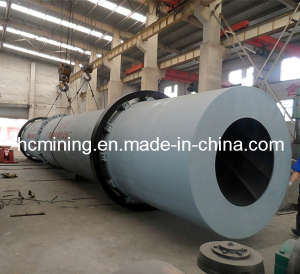General introduction:
The rotary dryer is a type of industrial dryer employed to reduce or minimize the liquid moisture content of the material it is handling by bringing it into direct contact with a heated gas. The dryer is made up of a large, rotating cylindrical tube, usually supported by concrete columns or steel beams.

Main features of rotary dryer:
1. By adopting air current drying methods, smoke and wet material entering the drying machine from the same side, which obtained high evaporation strength with the help of high temperature flue gas. The machine has remarkable features of low outlet temperature, high thermal efficiency, low fuel consumption; Low cost, strong anti overloads ability, large capacity.
2. With new feeding and discharging device, the machine prevent the phenomenon of feeding jams in traditional rotary drum dryer, reducing the load of dust collector. What's more, it can change the operating parameter according the different materials, which make the heat exchange more sufficient.
3. New internal structure strengthens the effect of cleaning and heat conduction, making the machine has a strong adaptability to the moisture and stickiness.
4. Coal slime dryer use changeable riding wheel, making the riding wheel contact the rolling ring in a linear way, so that largely reduce wear and tear of the machine.
5. It can control the granularity and moisture under the customer's request. We can control the product size under 8mm and moisture under 8%.

Working principle of rotary dryer:
The dryer slopes slightly so that the discharge end is lower than the material feed end in order to convey the material through the dryer under gravity. Material to be dried enters the dryer, and as the dryer rotates, the material is lifted up by a series of internal fins lining the inner wall of the dryer. When the material gets high enough to roll back off the fins, it falls back down to the bottom of the dryer, passing through the hot gas stream as it falls. This gas stream can either be moving toward the discharge end from the feed end (known as co-current flow), or toward the feed end from the discharge end (known as counter-current flow).

The rotary dryer is a type of industrial dryer employed to reduce or minimize the liquid moisture content of the material it is handling by bringing it into direct contact with a heated gas. The dryer is made up of a large, rotating cylindrical tube, usually supported by concrete columns or steel beams.

Main features of rotary dryer:
1. By adopting air current drying methods, smoke and wet material entering the drying machine from the same side, which obtained high evaporation strength with the help of high temperature flue gas. The machine has remarkable features of low outlet temperature, high thermal efficiency, low fuel consumption; Low cost, strong anti overloads ability, large capacity.
2. With new feeding and discharging device, the machine prevent the phenomenon of feeding jams in traditional rotary drum dryer, reducing the load of dust collector. What's more, it can change the operating parameter according the different materials, which make the heat exchange more sufficient.
3. New internal structure strengthens the effect of cleaning and heat conduction, making the machine has a strong adaptability to the moisture and stickiness.
4. Coal slime dryer use changeable riding wheel, making the riding wheel contact the rolling ring in a linear way, so that largely reduce wear and tear of the machine.
5. It can control the granularity and moisture under the customer's request. We can control the product size under 8mm and moisture under 8%.

Working principle of rotary dryer:
The dryer slopes slightly so that the discharge end is lower than the material feed end in order to convey the material through the dryer under gravity. Material to be dried enters the dryer, and as the dryer rotates, the material is lifted up by a series of internal fins lining the inner wall of the dryer. When the material gets high enough to roll back off the fins, it falls back down to the bottom of the dryer, passing through the hot gas stream as it falls. This gas stream can either be moving toward the discharge end from the feed end (known as co-current flow), or toward the feed end from the discharge end (known as counter-current flow).

| Model(mm) | Speed (r/min) | Slope (%) | Inlet Air Temperature | Power (kw) | Capacity (t/h) | Weight (t) |
| 800×8000 | 3-8 | 3-5 | ≤700 | 4 | 0.8-2 | 3.5 |
| 1000×10000 | 3-8 | 3-5 | ≤700 | 5.5 | 1-3 | 5.6 |
| 1200×10000 | 3-8 | 3-5 | ≤700 | 7.5 | 2-3.5 | 13.5 |
| 1200×12000 | 3-8 | 3-5 | ≤700 | 11 | 2.5-4 | 14.2 |
| 1500×12000 | 2-6 | 3-5 | ≤800 | 11 | 4-6 | 18.5 |
| 1500×15000 | 2-6 | 3-5 | ≤800 | 18.5 | 5-8 | 21 |
| 1800×18000 | 2-6 | 3-5 | ≤800 | 18.5 | 6-12 | 31 |
| 2000×18000 | 1.5-6 | 3-5 | ≤800 | 22 | 8-15 | 35 |
| 2200×12000 | 1.5-6 | 3-5 | ≤800 | 22 | 13-15 | 31.6 |
| 2200×14000 | 1.5-6 | 3-5 | ≤800 | 22 | 14-16 | 33.5 |
| 2200×16000 | 1.5-6 | 3-5 | ≤800 | 30 | 14-18 | 36 |
| 2400×18000 | 1.5-6 | 3-5 | ≤800 | 45 | 16-22 | 42.8 |
| 2400×20000 | 1.5-6 | 3-5 | ≤800 | 45 | 18-25 | 52 |
| 3000×20000 | 1.5-6 | 3-5 | ≤800 | 55 | 25-30 | 77.8 |
| 3000×25000 | 1.5-6 | 3-5 | ≤800 | 55 | 28-34 | 87.5 |





